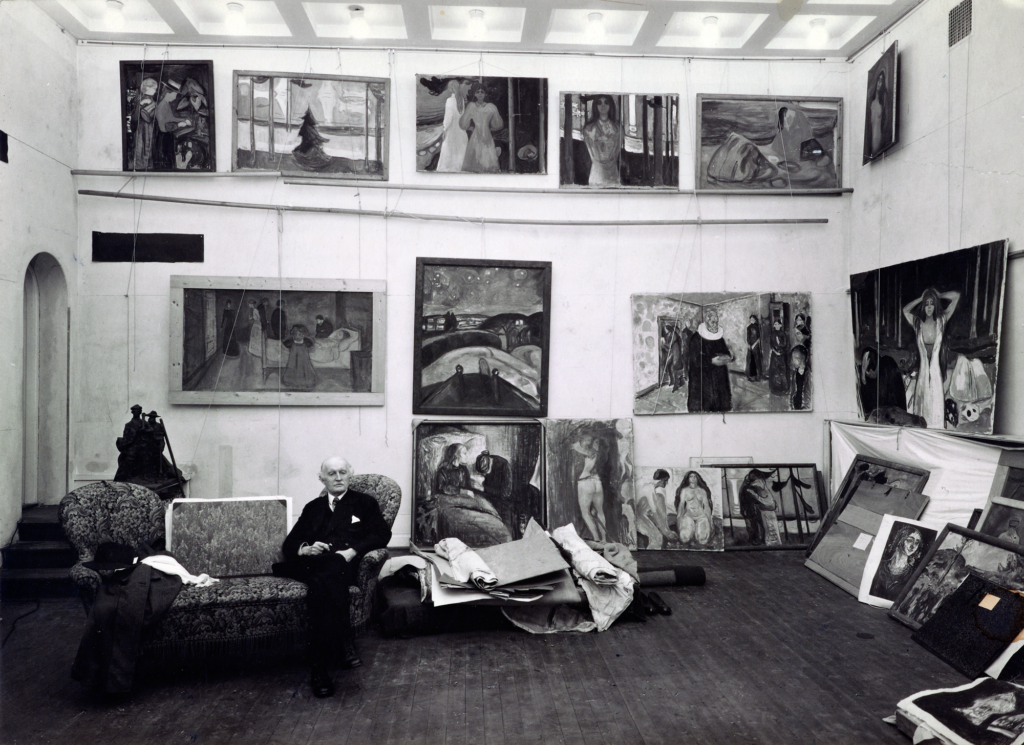
Edvard Munch, Munch Sitting in the Winter Studio, ca. 1938, © Munch Museum, Oslo
Edvard Munch’s 1893 painting The Scream is a global icon—standard decor in college dorm rooms everywhere, and as merrily spoofed on T-shirts and coffee mugs as the Mona Lisa. But its very ubiquity has cast a shadow over the rest of Munch’s six decades of work, and he’s frequently, and unfairly, written off as a one-hit wonder.
It doesn’t help that the majority of the artist’s work resides in Oslo in a dedicated Munch Museum. San Francisco first hosted a major exhibition of Munch’s paintings in 1951. Now, sixty-six years later, one of the greatest Western artists of all time—according to curators Gary Garrels and Caitlin Haskell, he’s right up there with Henri Matisse, Pablo Picasso, and René Magritte—is back. Garrels and Haskell have painstakingly selected approximately forty-five of Munch’s very best paintings (he created more than 1,700) and brought them to SFMOMA.
Loan-wise, they scored some major coups to pull together what they describe as a “jewel box” of a show. This is in part thanks to the encouragement of Kjetil Trædal Thorsen, the Norwegian partner at Snøhetta, the architects behind SFMOMA’s recent building expansion. “Because we worked with Snøhetta so closely on the building,” Garrels recalls, “we had occasion to travel to Oslo a few times, and had the good fortune to be there for an enormous exhibition—almost three hundred works—hosted by the National Museum and the Munch Museum on the sesquicentennial of the artist’s birth. We realized that he made numerous extraordinary paintings.”
Thorsen, among others, became an advocate for bringing a Munch show to the United States, specifically in the hopes of giving Norway and Munch a more prominent place on the international stage. The new friendships facilitated by SFMOMA’s expansion were just one of the factors that eventually helped the Munch Museum decide they felt comfortable lending their priceless works to faraway San Francisco.
With this momentum, other major holders of Munch’s work began to follow suit, including the National Museum of Art, Architecture, and Design, Oslo, and the Thiel Gallery in Stockholm, whose collection includes Munch’s Sick Mood at Sunset: Despair (1892). While the Theil Gallery had long wanted to expand the scope of their international loans program, they only recently got the greenlight, and fortunately for us made SFMOMA the very first beneficiary of the new policy. Other lenders who rarely part with their Munch paintings include KODE in Bergen, Norway; the Gothenburg Museum of Art, Sweden; and the Statens Museum for Kunst in Copenhagen, Denmark. Thus at SFMOMA, visitors will see in one place works that would otherwise require ambitious travel throughout Scandinavia.
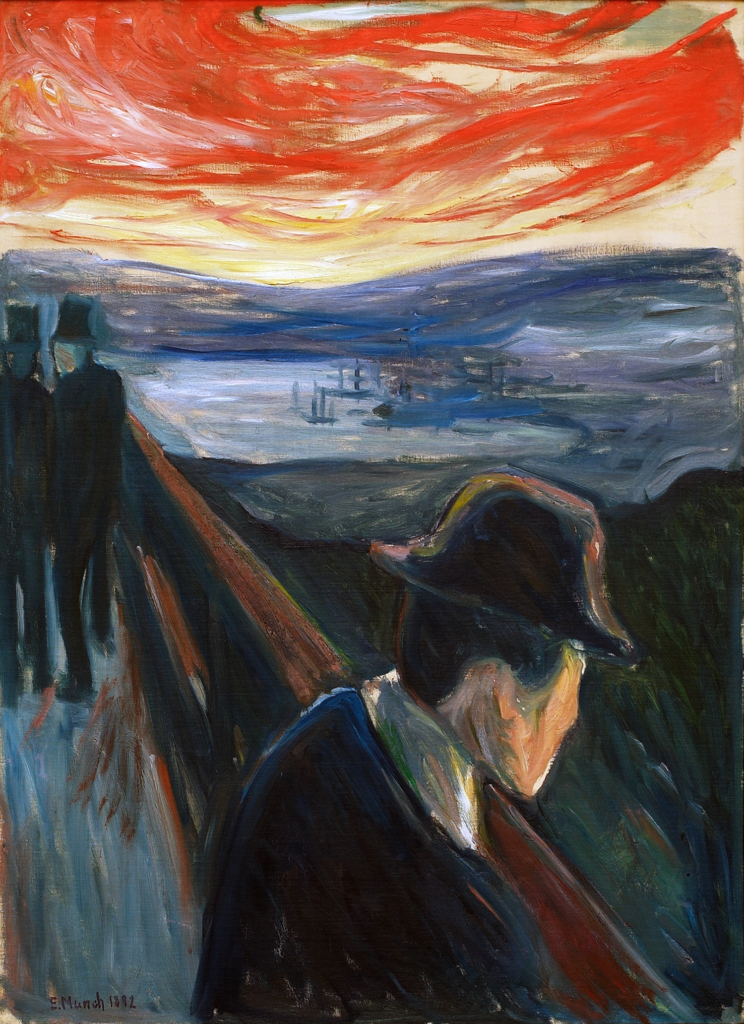
Edvard Munch, Sick Mood at Sunset: Despair, 1892; Thielska Galleriet, Stockholm
By including many works from the second half of his career, “we’re working against the grain of the prevailing idea that Munch had an incredibly inventive period of Symbolist work in the 1890s, but then subsequently wasn’t as engaged with the cutting edge of what was happening in art,” asserts Haskell. Along with co-curators Sheena Wagstaff and Jon-Ove Steihaug, she and Garrels settled on a single artwork — Self-Portrait: Between the Clock and the Bed (1940–43) — as the touchstone for a show that would not be organized around a set path (an unusual approach for SFMOMA), but rather radiate out in several directions. From that showcase piece, visitors can drift through themed rooms to witness the high points of Munch’s six-decade career.
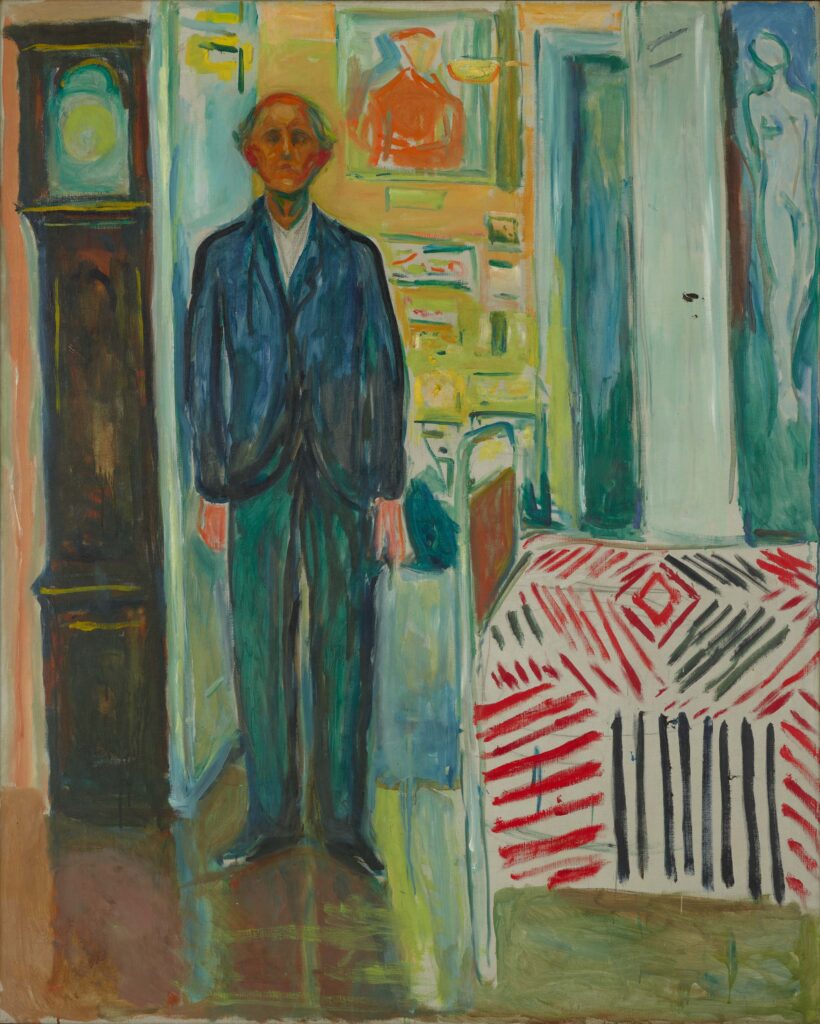
Edvard Munch, Self-Portrait: Between the Clock and the Bed, 1940–
“Self-portraiture is one of the themes,” says Haskell. “We see a lot of Ekely, where Munch lived and worked for the latter part of his career, in the gallery called ‘In the Studio.’ We have a rather serene selection of evening scenes called ‘Nocturnes.’ Another gallery deals very frankly with death. He was preoccupied by the precariousness of life, due to tragic events that happened in his childhood — the deaths of his mother and his sister Sophie — and different moments over the course of his life when he likely thought he was going to die. But, of course, he didn’t. He was able to keep on working until the last months of his live at age eighty.”
The show demonstrates the vast range of techniques Munch deployed over the course of his career. He labored over some pieces for months or years, even (notoriously) keeping them outside, uncovered, allowing them to accumulate water stains and bird droppings. He returned to many subjects again and again, either to satisfy a compulsion or because he was constantly creating his own themed groups of works, in a sense curating his own oeuvre.
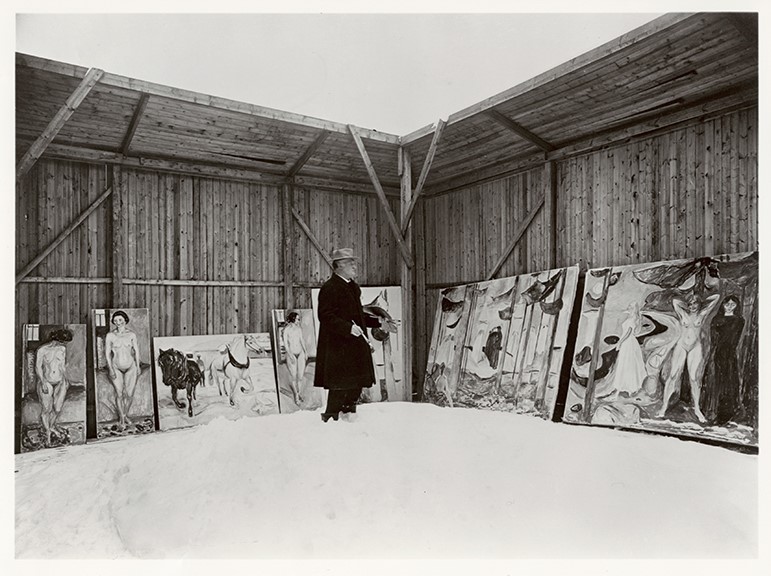
Edvard Munch, Munch in the Open Air Studio, ca. 1927; © Munch Museum, Oslo
“Many visitors will immediately note some obvious points of comparison to Vincent van Gogh,” Garrels notes. “In the 1890s, much like van Gogh, Paul Gauguin, and Paul Cézanne, Munch was creating a language in modern painting that would follow Impressionism. The exhibition includes a work from the 1920s called Starry Night (1922–24), which bears an unmistakable connection to van Gogh’s painting of the same name. And there’s a piece called Self-Portrait with Hand under Cheek (1911) that is an overt quotation of van Gogh’s Portrait of Dr. Gachet (1890).”
By around 1900, Munch had achieved international recognition, and was known specifically for pushing boundaries. “In Berlin in 1892, an exhibition of his was immediately shut down, after just a week of being on view, because it provoked such a scandal,” Haskell notes. “But by the time of the Sonderbund exhibition in 1912, when Munch was still in his forties, he was already being canonized as one of the modern masters. What this meant for him was that he largely had the financial freedom to withdraw from the art market and work for himself.”
Munch moved back to Norway in 1911 and lived there until he died in 1944. Deeply concerned with how his history would be written and apprehensive about the potential dispersal of his oeuvre, he kept the majority of his new works instead of selling them. After the Nazis occupied the country in 1940, Munch worried that they might seize his works, so he bequeathed them to his home city of Oslo in the hopes that that would protect them.
“This is why you normally have to go to Oslo, and particularly to the Munch Museum, to understand the work from the second half of his career,” concludes Garrels. “I have to say that for me, one of the major epiphanies of seeing that enormous Munch retrospective in Oslo was understanding that The Scream is such an iconic picture, but certainly far from the best one. There are many others that I think are more important and more gloriously painted. That’s one reason why our exhibition does not include The Scream. The aspiration is to give people an expansive understanding of Munch, to fill out an appreciation of him by focusing on the totality and the variety of his painting.”
That variety includes a deep dive into an exceptionally dramatic worldview. Munch comes across, the curators agree, as an emotionally wrought personality and artist. “There’s this sense of, ‘I’m personally telling you this story, I’m confessing these personal secrets,’” says Haskell. “And he was ahead of his time in the sense that he had adopted certain strategies of managing his public image that we might more readily associate with someone like Andy Warhol. He was interested in self as persona and celebrity, and so inserted himself almost as if a character into different stories.”
One famous instance, at least among Munch scholars, is Self-Portrait with the Spanish Flu (1919). To the best of anyone’s knowledge, Munch never had the Spanish flu, which claimed tens of millions of lives around the world just after World War I. But it was a dramatic and highly topical subject that affected many families in Norway, so he depicted himself sick and suffering from it. He was constantly drawn to the theatrical, the imaginary, the fantastic. Birth, death, love, and conflict, for instance, and tensions between male and female. This artist was not one to separate art from life.
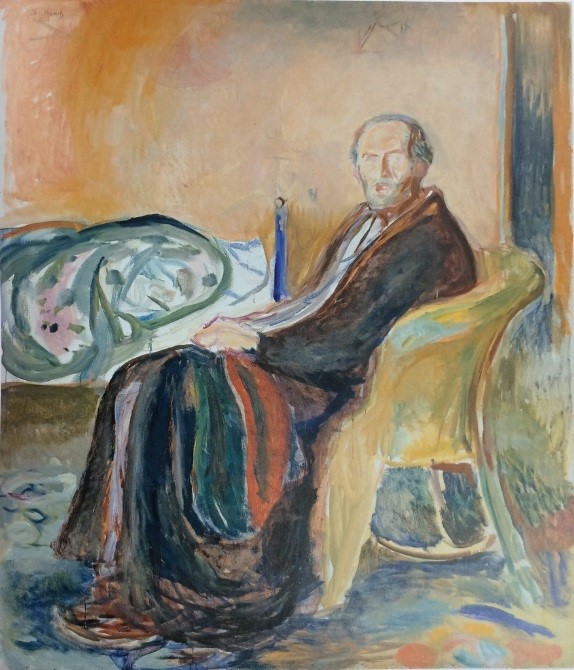
Edvard Munch, Self-Portrait with the Spanish Flu, 1919; National Museum of Art, Architecture, and Design, Oslo
The curators hope that the exhibition will resonate particularly in the San Francisco Bay Area given the region’s robust history of figurative painting. When Munch’s late work was first shown here in 1951, critics and local artists alike were bowled over to suddenly encounter the entire career of a fully formed, mature artist, whose name they knew, but whose twentieth-century paintings were almost entirely unknown here. “Seeing forty to fifty years of development all at once was a revelation,” says Garrels. “Art historians have actively discussed how this 1950–51 exhibition was received in New York. Here in San Francisco its effects are far less frequently discussed, but it’s clear how it would have reinforced a growing interest in figurative painting among Bay Area artists, including David Park and Elmer Bischoff, and left a deep impact on Bay Area painters.”
Haskell agrees: “Munch was interested in rigorous figuration. When you look at his work, you see that he understands material power in the same way that an abstract painter does, but he’s always working in the service of telling a story, creating a narrative structure or a figurative scene, that marries the language of making the painting with its thematics. Abstraction was never enough for him.
“If he’s painting a scene about sickness, he’s going to show you something about sickness—about emotional sorrow and physical breakdown—through the materiality of the paint. It’s not like a Cézanne, where each touch is a record of sensation, moving across the canvas in an orderly way. The ends toward which Munch was painting are so direct and so primal that we might not even have words for it.”